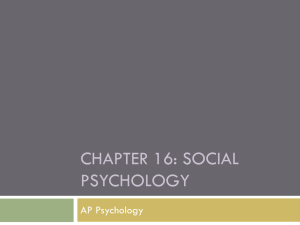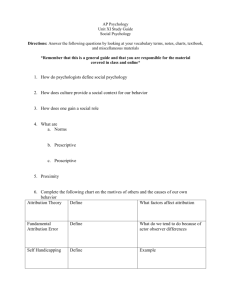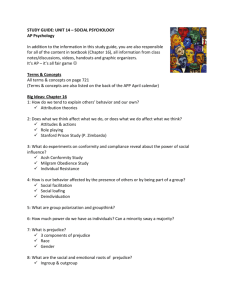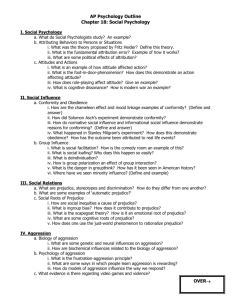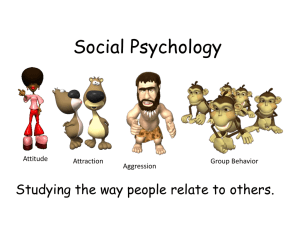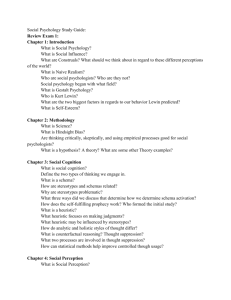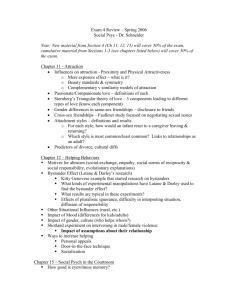File
advertisement
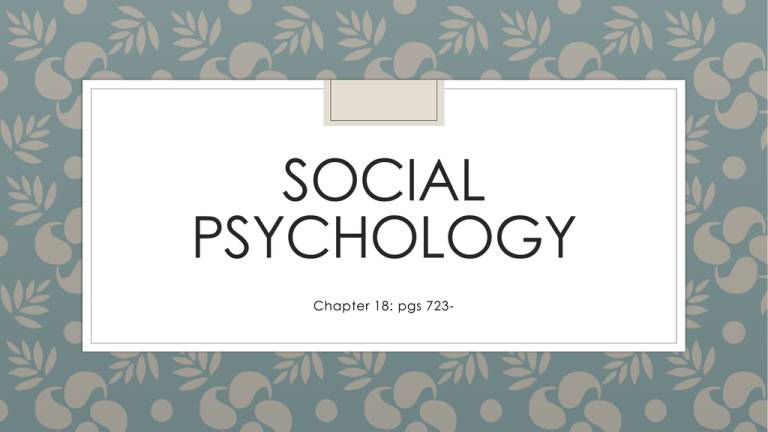
SOCIAL PSYCHOLOGY Chapter 18: pgs 723- Social Psychology ◦ The study of how we think about influence, and relate to one another SOCIAL THINKING Pgs 723-730 Heider’s Attribution Theory ◦ People tend to explain behavior as a product of internal behavior or external situations ◦ Ex. Student acts out: behavior is either a product of stress or is he an aggressive student ◦ Fundamental Attribution Error: tendency to over estimate disposition and underestimate situation ◦ William’s College Study: people blamed behavior on personality even when told it was situational ◦ We assume we are less likely to commit this error compared to others Application of Attribution ◦ Understanding of behavior contributes to individuals’ relationships ◦ Marriages: it is the fault of the person versus the situation ◦ Politics: do they collect unemployment because they are lazy versus fallen on hard times ◦ Employers: did they preform poorly because they have low ability or impossible demands ◦ How does attribution affect our response? Attitudes and Actions ◦ Attitudes: feelings that predispose us to respond in a certain way to objects, people, events, etc. ◦ Attitudes affect how we perceive our surroundings ◦ Behavior can also shape attitudes ◦ Foot-in-the-door phenomenon: if you get people to agree to a small action then they are more likely to agree with a larger one later ◦ If you give a mouse a cookie ◦ Philip Zimbardo’s prison experiment Cognitive Dissonance ◦ Cognitive Dissonance: tension created when there is contradiction between actions and thoughts (or two actions/two thoughts) ◦ Offers one explanation as to why we adjust our beliefs to fit actions ◦ Ex. Iraq War, torture, etc. ◦ Provides evidence for the “fake it until you become it” school Cognitive Dissonance Can you explain the cognitive dissonance? SOCIAL INFLUENCE PG 730-742 Conformity and Obedience ◦ Chameleon Effect: humans unconsciously mimic others ◦ Explains mood linkage (sharing up and down moods) and suicidal clusters ◦ Those who want to fit in with the group tend to exhibit this more ◦ Conformity: adjusting behavior to match a group standard ◦ Solomon Asch: line length conformity Why Conformity ◦ Factors that strengthen conformity ◦ Group > 3 people ◦ Subject feels incompetent/insecure ◦ Group is unanimous ◦ Group is admired ◦ Open observation ◦ Cultural respect for social standards ◦ Reasons behind conformity ◦ Normative social influence: influence from desire to gain approval/avoid disapproval ◦ Informational social influence: influence from one’s willingness to accept others opinions Obedience ◦ People generally follow what they are told to do ◦ Milgram’s Pain Experiment: Majority of participants obeyed until the end (see graph on page 735) ◦ Debated ethics: heavily utilized stress and deception, but no participants illustrated any long term affects ◦ Foot in the door ◦ Factors that influence obedience ◦ Authority is legit, male, and close ◦ Authority is affiliated with a prestigious institution ◦ Victim was depersonalized or distant ◦ No role model for defiance Group Influence ◦ Social Facilitation: stronger responses on simple or well-learned tasks in the presence of others ◦ E.g. Running ◦ On tougher tasks we do worse with others around ◦ Arousal theory ◦ Proximity maximizes experience: comedy, friendliness ◦ Social Loafing: exert less effort in a group task versus an individual task ◦ Most common among men in individualist cultures ◦ Less accountable, less judgment, less important ◦ Deindividuization: loss of self-awareness and self-restraint in group situations that foster arousal and anonymity ◦ E.g. Food fight! ◦ Affect of attire? Effects of Group Interaction ◦ Group Polarization: discussion strengthens inclinations ◦ Differences between groups occur over time ◦ E.g. Politics, religion, race ◦ Effect of technology? ◦ Group Think: desire for harmony in a decisionmaking group overrides a assessment of alternatives ◦ E.g. Kennedy and the Bay of Pigs Power of Individuals ◦ Social and personal control interact ◦ People do say no ◦ Minority Influence: power of one to sway majorities ◦ Important to be resolute ◦ Privately people develop sympathy for the minority ◦ Why do some people say no? SOCIAL RELATIONS Pgs Prejudice ◦ Unjustifiable (usually negative) attitude toward a group and its members ◦ Mixture of beliefs, emotions, and predispositions to action ◦ Discrimination is a negative behavior ◦ Outward, obvious prejudice has declined ◦ In less public settings people still tend to cling to prejudice practices ◦ We claim factors other than prejudice for prejudice behaviors ◦ Certain prejudice still exists ◦ Immigration ◦ Homosexuality ◦ Race ◦ Gender Origins of Prejudice ◦ Social Inequality ◦ The “haves” justify their status (think cognitive dissonance) ◦ Prejudice rationalize inequality ◦ Blame-the-victim feed forward cycle: povertycrimemore discrimination against the poor ◦ In-group versus out-group ◦ Founded in evolution: belongingness ◦ Who you aren’t is tied up in who you are ◦ We favor the ingroup: ingroup bias versus outgroup biasprejudice against the other and strangers Emotional and Cognitive Origins ◦ Emotional Roots ◦ When in danger us/them phenomenon grows ◦ Angerprejudice: we like having someone to blame ◦ Scapegoat theory: we feel better about ourselves when someone is brought down ◦ Cognitive Roots ◦ Desire to simplifycategorizationstereotypes ◦ Vivid Cases: we are more likely to remember extremes and thus base assumptions off of them ◦ Just-World Phenomenon: people get what they deserve ◦ Hindsight bias: who’s at fault in cases of rape…she should have known not to get into the car! ◦ This helps reassure us that it can’t happen to us too. Aggression ◦ Aggression: any physical or verbal behavior intended to hurt or destroy ◦ Biology of Aggression ◦ Genes ◦ Identical twins often share violent tempers ◦ Gene on the Y-chromosome connected to violence ◦ Neurology: amygdala stimulationmore aggression, lower frontal lobe controlmore aggression ◦ Biochemical Influences: hormones, alcohol, and blood substances ◦ Testosteroneaggression (effect of castration) ◦ Feedforward: testosteronedominancemore testosterone ◦ Violent individuals tend to have lower levels of serotonin Psychological Causes of Aggression ◦ Aversive Events ◦ Frustration-aggression principle: frustrationaggression (especially in the presence of aggression symbols/cues) ◦ Rejection-induced aggression ◦ Pain, insults, foul odors, heat, cigarette smoke, et. al. evoke aggression ◦ Geography? Global Warming? ◦ Conditioning ◦ Children learn aggression scares others, repeat aggression ◦ Affect of cultural tradition ◦ Parent Training ◦ Observation ◦ Parent Training ◦ Media violence ◦ Pornography and rape (pg 753-754) Psychological Causes of Aggression ◦ Acquiring Social Scripts ◦ Many factors predispose one to violence ◦ Dominance, alcohol, history of child abuse, media, father presence, etc. ◦ Media gives us social scripts or guides on how to behavior in certain situations ◦ Video Games?? ◦ Catharsis Hypothesis ◦ We feel better if we vent our emotions ◦ But video games seem to increase aggressive thoughts, emotions, and behaviors Causes of Conflict ◦ Conflict: incompatible actions, goals, or ideas ◦ Social Traps: situation where conflicting parties, each behaving according to self interest, become caught in mutually destructive behavior. ◦ People are self-interested ◦ Game Theory and the Prisoners Dilemma ◦ Person one has $10 to split between themselves and person 2. Person 2 doesn’t get to negotiate but can accept or reject the offer. If P2 rejects the offer no one gets money. ◦ Solutions: regulation, communication, awareness ◦ Enemy Perception ◦ Mirror-image perceptions feed a cycle of hostitility ◦ Self-fulfilling prophecies Peace Making: Cooperation ◦ If parties are at equal status in a non competitive environment cooperation can help over come stereotypes ◦ Mirror-image misperceptions need to be corrected ◦ Superordinate goals help (goals that override differences and require cooperation) ◦ Helps us discover similarity ◦ Particularly beneficial when we create new groups that dissolve subgroups ◦ Ex. moving, the new us and them Peace Making ◦ Communication ◦ Remember game theory ◦ Third-party mediators ◦ Often leads to cooperation: move from a win-lose to a win-win ◦ Conciliation ◦ GRIT: Graduated and Reciprocated Initatives in TensionReduction 1. Announces its recognition of mutual interests and interest to reduce tension 2. Initiates one+ small conciliatory acts 3. Reciprocate ◦ Improves trust and cooperation ◦ Act can be of any size (e.g. smile)climb down the ladder Attraction: Psychology of Attraction ◦ Proximity: Geographic nearness ◦ Most powerful predictor ◦ Why? ◦ Availability ◦ Mere exposure effect: familiarity breeds fondness ◦ Seen in our preference for ourselves (or those who look like us) ◦ In-group v. out-group Psychology of Attraction ◦ Physical Attractiveness ◦ We perceive a lot about attractive people: health, happiness, successful, sensitive, social, etc. (less honest and compassionate) ◦ Correlation between income and attractiveness ◦ In media pretty people are the good guys, bad people are the bad guys ◦ Attractiveness is subjective and doesn’t relate to self esteem ◦ Universal components of attractiveness: moderately sized features and symmetrical features ◦ Chicken or the egg: are you beautiful to me because I love you or do I love you because you’re beautiful Psychology of Attraction ◦ Similarity ◦ Typically we like people who are also like us ◦ The greater the similarity the more enduring the attraction ◦ In group versus out group ◦ Other factors ◦ We like people who like us ◦ Reward theory of attraction Romance ◦ Passionate love ◦ Physical arousal+cognitive appraisal ◦ Any arousal can enhance an emotion ◦ Compassionate love ◦ Passion fades and deeper and affectionate attachment grows ◦ Evolutionary purpose: Passion breeds children, how do we keep parents together to raise kids? ◦ Keys ◦ Equity: freely give and receive from each other ◦ Self-disclosure: sharing intimate details about ourselves Altruism ◦ Altruism: unselfish regard for the welfare of others ◦ Bystander Intervention ◦ We help when: 1) we notice 2) we interpret the situation as an emergency 3) we assume responsibility ◦ Presences of others deters helping: bystander effect ◦ We focus more on ourselves when in large crowds ◦ We interpret other’s ambivalence to mean it’s no big deal ◦ Diffusion of responsibility ◦ Women more likely to receive help than men ◦ We are more likely to help when: victim appears to need/deserve help, victim is similar to us, we have just observed someone else being helpful, we are not in a rush, we are in a small town/rural area, we are feeling guilty, we are focused on others/not distracted, we are in a good mood Helping Norms ◦ Self-interest determines all human behavior ◦ Econ.: Cost/benefit, Philosophy: utilitarian, Psychology: Social Exchange Theory ◦ Reciprocity Norm ◦ Help those who have helped you ◦ Give what you have been given ◦ Social-Responsibility Norm ◦ Help those who need help (e.g. young, old) even if cost>benefits ◦ People who attend regular services are more likely to follow this norm
